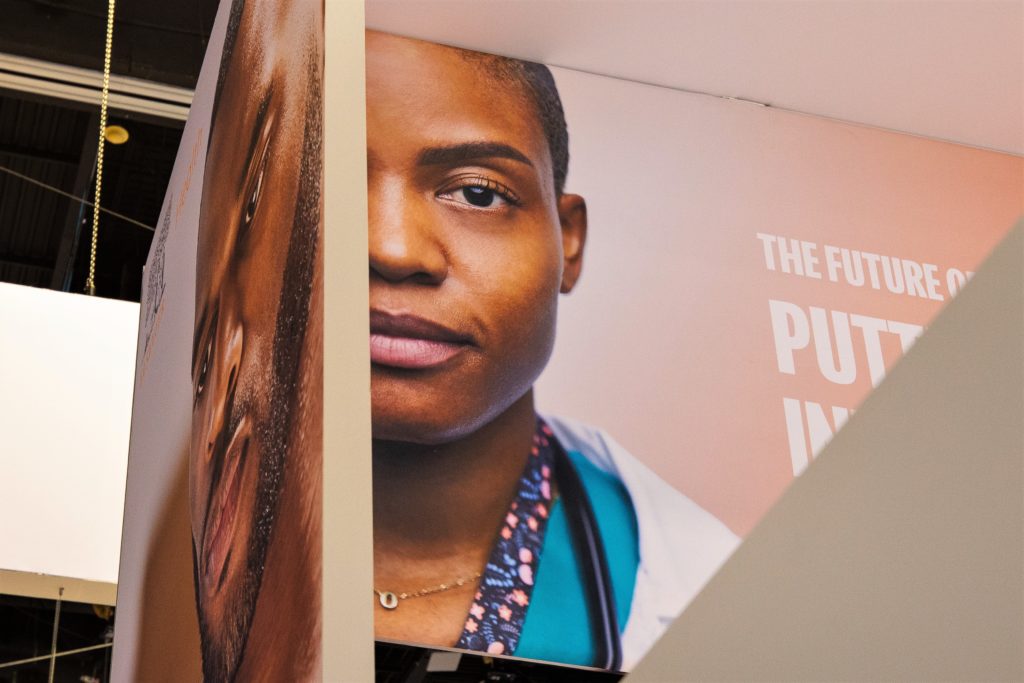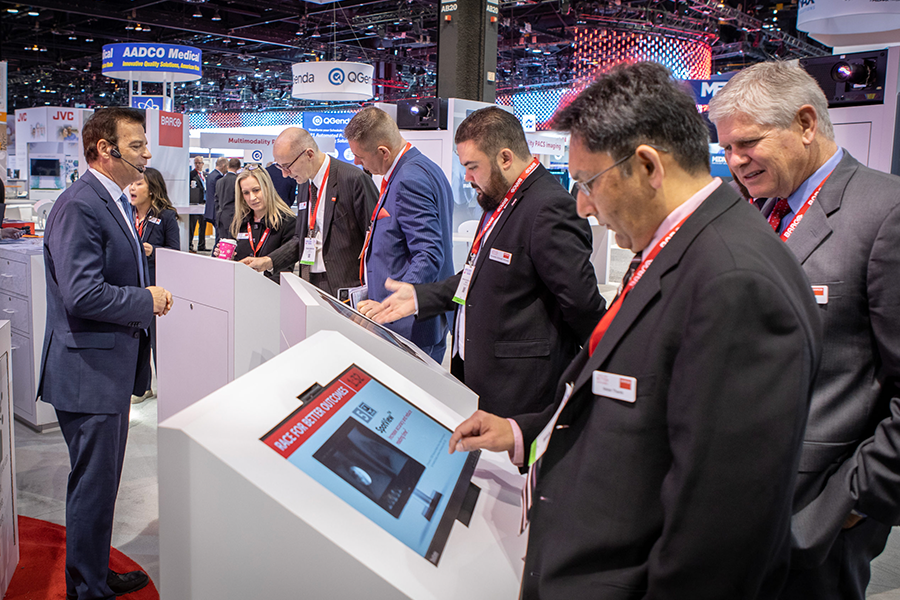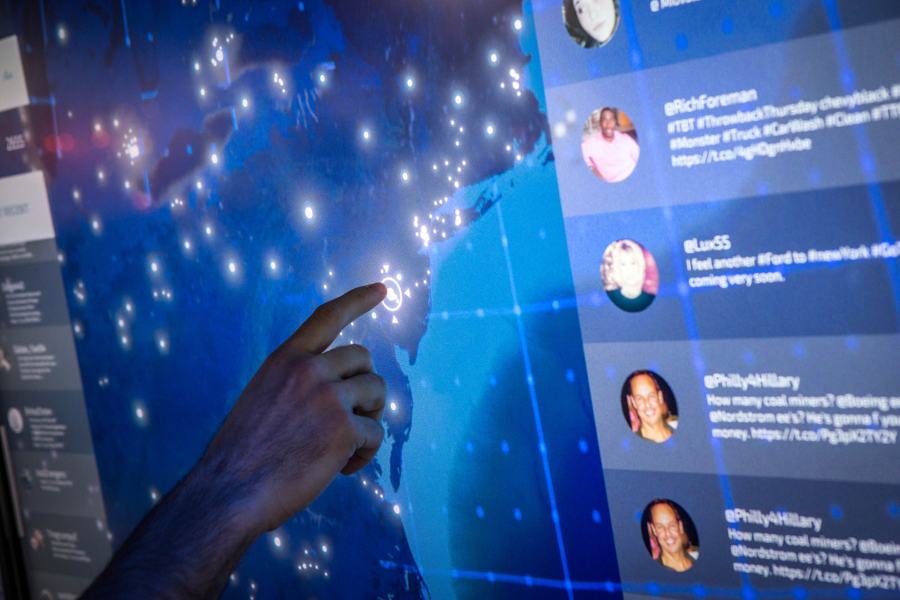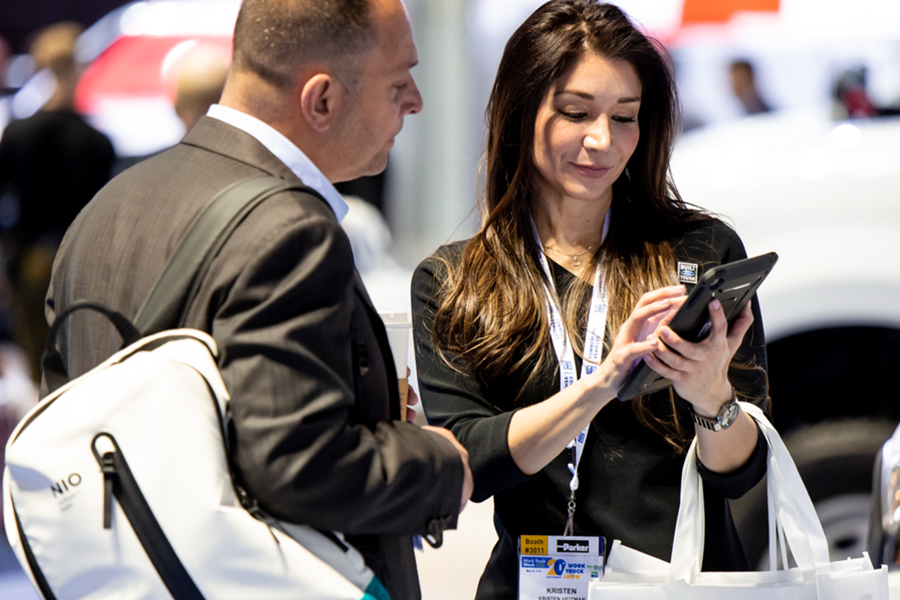Unleash your creativity and let your booth activation be the spark that lights up your attendees.
In the trade show world, a successful activation engages attendees, leaving them not only with a memorable experience, but also with a better understanding of your brand and its offerings. But implementing the right event activation is not always intuitive to event professionals. How can marketers design activations that not only capture attention but also effectively communicate their brand’s message? The truth is, successful activations require careful planning and creativity, and a production team that understands how to create traffic flow and a pull-through strategy in an event environment. When we design impactful brand activations for our exhibitor clients, we consider many key elements. Here are some of them:
- Set Clear Objectives and Goals
Begin by defining your goals. This is paramount to a brand’s success. Plan and write out what you want to achieve with your booth activation. Are you looking to generate leads, increase brand awareness, launch a new product, educate your audience? Maybe it’s a combination. Having clear objectives will guide your design and messaging. Create SMART goals: Define specific, measurable, attainable, realistic, and timely objectives for your booth activation. Maybe you want to generate 200 leads, increase brand awareness by 20%, or launch a new product with a target of 500 product demonstrations. By providing your team with precise objectives, it creates an understanding and allows the team develop activations and experiences that align with those goals.
- Understand Your Audience
Tailor your booth activation to resonate with your target audience. You could consider conducting surveys or research before the event to gather insights and gain a keener understanding of your target audience’s demographics, interests, pain points, and preferences. This would help you to create buyer personas to guide your messaging and design choices. This understanding will help you create experiences that are most accessible to your audience, such as utilizing technology, images, and having a user experience that resonates with them.
- Create a Compelling Theme
Themes work. They make it easier for attendees to connect with your brand. Choose a theme that aligns with your business and event goals. The theme should be visually appealing and memorable. It should also be flexible enough to accommodate various elements. And don’t be shy about creating something catchy, that is visually striking and able to capture attention immediately. For example, a cybersecurity company used a Spy Theme at a leading security show. Also successful was a marketing agency that created a storybook theme encouraging attendees to tell their stories. Another example was a travel agency that transformed its booth into an “Adventure Island” with sand, palm trees, and a mock beach where attendees could take virtual reality tours of exotic destinations and win trips. At RIMS, Gallagher Bassett put together a graphic novel themed booth based on a company character they had created where attendees could become part of the comic book adventure.
- Engaging, Accessible Visuals
Invest in eye-catching visuals by using high-quality graphics, signage, and multimedia displays to attract attention. Ensure that your branding is consistent and prominent throughout the booth. Use colors, imagery, and typography that reflect your brand identity and the chosen theme. While it is imperative to create visuals that will resonate with your audience, it’s equally important to consider accessibility for all attendees. For example, utilize fonts and colors that are easy to read. With as many as 1 in 5 people having dyslexia (Yale Center for Dyslexia and Creativity) it is important to create graphics and other visuals that are accessible to all. Finally, consider diversity, equity, and inclusion in your visual displays. Think about how you can be more inclusive of your entire target demographic and show that in your visual elements.
- Interactive Elements
Incorporate interactive elements to engage visitors. This could include games, virtual reality experiences, product demonstrations, or hands-on activities related to your products or services, and make sure they encourage participation. For example, if you’re a food brand, set up a tasting station. If you sell tech products, have interactive demos or games related to your products. Another area to consider is accessibility. User interfaces must be intuitive and easy to navigate. If the interactive includes a screen, the buttons must be the optimized, so the screen is easy to use.
- Storytelling
Connect with your audience emotionally through storytelling. Tell a powerful story that shows what your brand stands for, including your brand’s journey, beliefs, and solutions that your audience is interested in. For trade shows, your story should be short and catchy, making sure it highlights how you solve problems, meet needs, and discusses your uniqueness and distinction. A good rule of thumb is to put yourself in the shoes of your attendees and tell your brand story with them as the hero.
- Educational Content
Provide informative content that adds value to your audience. This can be in the form of workshops, presentations, games, demos, or informative displays. Offer solutions to common problems or challenges your audience faces. Host workshops, presentations, or demonstrations that address topics relevant to your industry and products. This establishes your authority and expertise.
- Technology Integration
Technology can make your booth more engaging and memorable. This could include augmented reality (AR), virtual reality (VR), large format LEDs, or interactive touchscreens. AR or VR experiences can transport visitors to a different world, while interactive touchscreens can provide product information and allow customization. Make sure the technologies fit your brand and message. If you are not introducing new technology, pick something that most attendees are somewhat familiar with, so they don’t have to learn it on-site.
Bonus tip: When designing for the event space, consider how you may be able to repurpose your content for other formats. This is a cost-effective method to reach a wider audience long after the event is over.
- Giveaways and Swag
Have a strategy for how you will offer giveaways and swag to attendees. Make the item something that the attendee would want to complete an activity for in order to receive the gift, such as watch a demo/presentation or participate in a contest. Offering a promotional item or giveaway that is both useful and branded helps extend your reach and memorability beyond the event.
- Staff Training
Booth training can make or break your trade show program. Your best laid plans can fall flat if your team doesn’t know what they are or how to communicate them. Plus, you want everyone on the same page. Your booth staff should not only be knowledgeable, but they should be approachable and enthusiastic as well. They should be able to communicate your brand’s message effectively, answer questions, and engage in meaningful conversations with visitors. Selling at an event or in a trade show space is not the same as selling in the field, and it takes a special kind of personality to feel comfortable in approaching attendees and welcoming them into the space. Those employees that excel in the trade show world should be invited to other events. One fun thing you could do is foster a little friendly competition by offering an incentive for performing well.
Pro-tip! Complement your booth staff with trained brand ambassadors who can take leads and guide attendees through activations while your team focuses on in-depth sales conversations with interested attendees. This ensures that your team is free to do the important work of connecting and communicating with likely prospects.
- Measurable Metrics
Define key performance indicators (KPIs) to measure the success of your booth activation. This could include metrics like the number of leads generated, social media engagement, or post-event sales. These could also include the percentage of attendees who engage with your activation, and post-event sales attributed to the event.
- Feedback and Adaptation
Collect feedback from attendees about your activation during and after the event and then use the feedback to refine your activation strategy and identify areas for improvement in the future. One way you can gather feedback is by using exit surveys or quick one-touch responses to questions about their experience.
- Sustainability
Be mindful of sustainability. Use eco-friendly materials and consider the environmental impact of your activation design. Communicate your commitment to sustainability in your messaging if it aligns with your brand values and select giveaways that are eco-friendly.
- Pre-event Promotion
Generate buzz before the event through social media, email marketing, ad campaigns, and event announcements. Encourage attendees to visit your display by teasing what they can expect to experience. Make them eager for your booth activation with smart pre-event marketing to spark interest and attract visitors. And for more exposure, use sponsorships to boost your audience.
- Follow-up Strategy
All is for naught if you don’t have a plan to follow up with leads and contacts made at the show. It’s imperative to develop a comprehensive follow-up plan to nurture those leads and contacts. A couple of ideas include sending personalized thank-you emails, providing additional product information in those emails, and tracking the progress of leads through your sales funnel.
SUMMARY
In the trade show industry, booth activations have emerged as a powerful tool to cut through the noise and make a lasting impression on your target audience. By following the comprehensive steps outlined in this guide, businesses can transform their booth spaces into dynamic hubs of engagement, effectively capturing attention while communicating their brand’s message.
➡️ Remember, setting clear objectives is the North Star of your booth activation strategy. Know what you want to achieve, whether it’s generating leads, increasing brand awareness, or launching a new product. Understanding your audience is equally pivotal. The better you know their preferences, the more tailored and impactful your activation can be.
➡️ A compelling theme is the cornerstone of your booth’s visual identity. It should not only align with your brand but also be memorable and inviting. Engaging visuals, interactive elements, and technology integration work together to captivate your audience. These elements create an immersive experience that not only attract visitors but keep them engaged throughout their journey at your booth.
➡️ Storytelling is your secret weapon, enabling you to forge emotional connections and communicate your brand’s essence. Educational content positions your brand as an authority in your industry, fostering trust and credibility.
➡️ Giveaways and swag, when chosen thoughtfully, can extend your brand’s reach far beyond the event.
➡️ Your booth staff, trained to be knowledgeable, approachable, and enthusiastic, play a vital role in delivering your brand’s message effectively. They are the human face of your activation, making personal connections with attendees.
➡️ Measurable metrics provide the data you need to evaluate your success objectively. Gathering feedback and adapting your strategy based on insights is crucial for continuous improvement.
➡️ Sustainability considerations, pre-event promotion, and a well-thought-out follow-up strategy demonstrate your commitment to both environmental and customer care.
Designing booth activations that capture attention and effectively communicate your brand’s message is a multifaceted endeavor. It’s about creating an immersive and memorable experience that resonates with your audience and aligns with your objectives. By utilizing some of the strategies above and staying creative and adaptable, brands can ensure that their booth activations leave an indelible mark on event attendees, setting the stage for lasting brand success in the ever-competitive market. So, go ahead, unleash your creativity, and let your booth activation be the spark that lights up your attendees.
Even the smallest details matter in event planning. Nothing is insignificant or trivial. At TPG, we work with you to apply the tips from this article, so you can focus on the main goal. Let’s chat and explore the possibilities!





